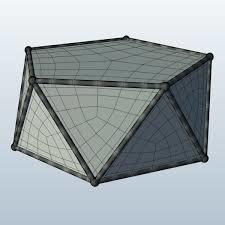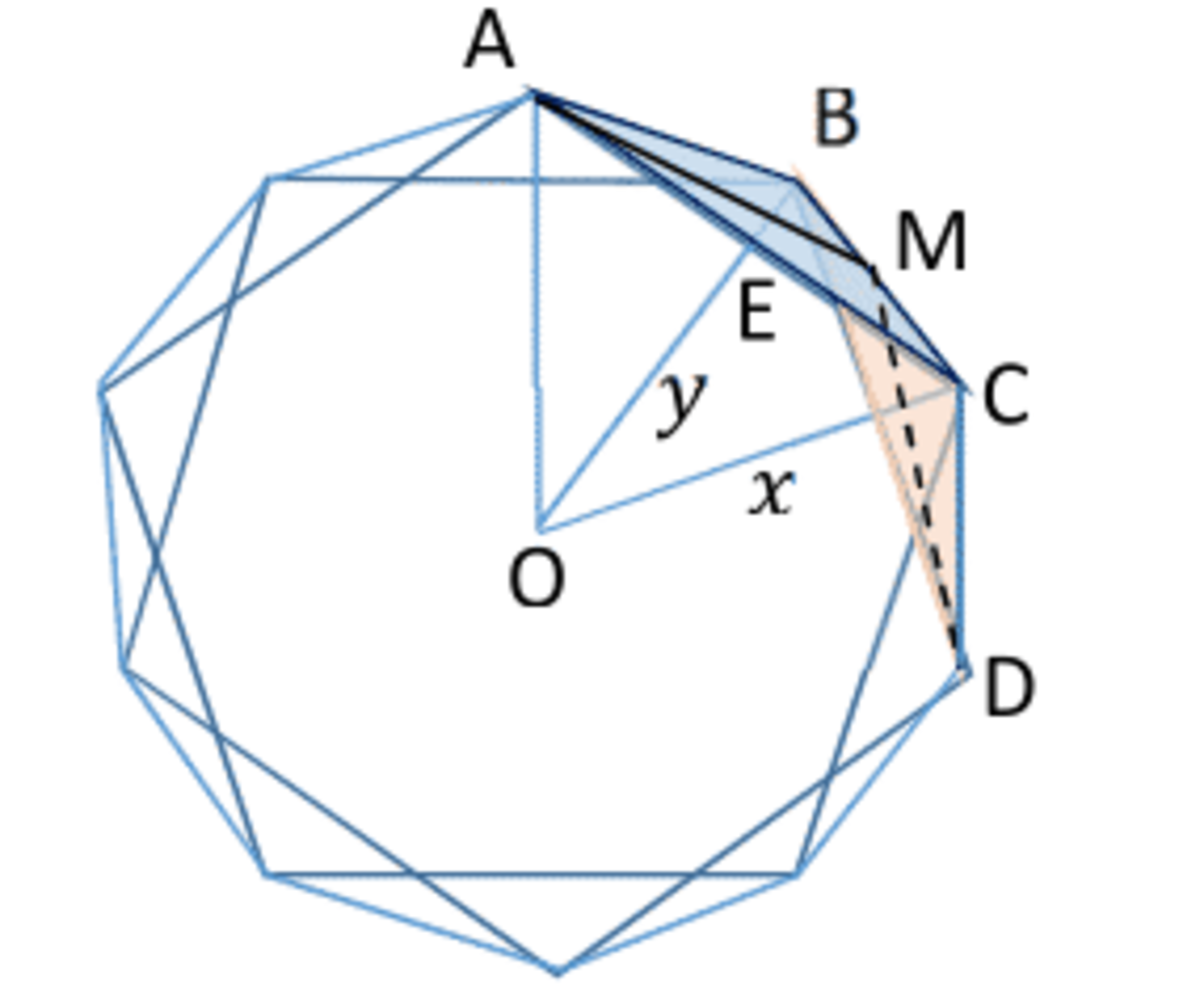Opposing Pentagons

The sides of the solid are two regular pentagons connected by a double layer of equilateral triangles. Find the angle between the planes of two adjacent triangular sides (in degrees).
Give your answer to 2 decimal places.
Image credit: Wikipedia.
The answer is 138.19.
This section requires Javascript.
You are seeing this because something didn't load right. We suggest you, (a) try
refreshing the page, (b) enabling javascript if it is disabled on your browser and,
finally, (c)
loading the
non-javascript version of this page
. We're sorry about the hassle.
3 solutions
Suppose the top and bottom pentagons both could be inscribed in a unit circle, one pentagon is in the x-y-plane, the other one is in the plane z=h. Then one pentagon has vertices ( cos 5 2 k π , sin 5 2 k π , 0 ) and the other has vertices ( cos 5 ( 2 k + 1 ) π , sin 5 ( 2 k + 1 ) π ) , h ) .
First find h.
A side of a pentagon, for example between ( 1 , 0 , 0 ) and ( cos 5 2 π , sin 5 2 π , 0 ) has squared length ( cos 5 2 π − 1 ) 2 + sin 2 5 2 π + 0 = 2 − 2 cos 5 2 π = 1 . 3 8 1 9 6 6 , this should be equal to the squared length of an edge connecting the pentagons, which is 2 − 2 cos 5 π + h 2 = 0 . 3 8 1 9 6 6 + h 2 , so it turns out that h = 1 .
Now find the distance d between the tops of two adjacent triangles. The distance between ( cos 5 2 π , sin 5 2 π , 0 ) and ( cos 5 9 π , sin 5 9 π , 1 ) is 1 . 9 0 2 1 1 3 .
The height of a triangle is 2 1 3 times a side of it, so 2 1 3 2 − 2 cos 5 2 π = 1 . 0 1 8 0 7 3 9
The sine of the angle α we are looking for is half the distance divided by the triangle height.. sin ( α / 2 ) = 1 . 9 0 2 1 3 / ( 2 × 1 . 0 1 8 ) and α = 2 arcsin ( 0 . 9 3 4 1 7 ) = 1 3 8 . 1 9 °

The image pictures the solid as seen from above one of the pentagonal faces. Triangle △ A B C , foreshortened in the image, is in reality an equilateral triangle with side 1. The distance x from the center of the pentagon to its vertex can be obtained from △ O E C using the fact that ∠ E O C = 3 6 ∘ and E C = 1 / 2 .
x = 2 s i n ( 3 6 ∘ ) 1 = 0 . 8 5 0 6 5
O E = y = x × c o s ( 3 6 ∘ ) = 0 . 6 8 8 1 9
The foreshortened distance E B = x − y = 0 . 1 6 2 4 6 (foreshortened due the slant of the △ A B C ). However in reality E B is the height of an equilateral triangle side 1, that is its length is equal to 3 / 2 . From this we can get the perpendicular distance between the pentagons as h = 3 / 4 − ( x − y ) 2 = 0 . 8 5 0 6 5 (same distance as the x = O C interestingly enough.)
To get the angle between two adjoining triangles, we will use triangles △ A B C and △ B C D . The lines A M and M D are perpendicular to B C and are both equal 3 / 2 . If we can find the actual distance between A and D, we can use the △ A M D to calculate the angle between the adjoining triangular faces.
Horizontal component of the distance A D (that is the one in the plane of the pentagons), can be obtained from the fact that both A and D are x from O, and that ∠ E O D = 7 2 ∘ + 3 6 ∘ . It comes to 2 × x × s i n ( 5 4 ∘ ) = 1 . 3 7 6 3 8 . Vertical component of the distance is the distance between the planes of the pentagons h . So the actual
A D = 1 . 3 7 6 3 8 2 + h 2 = 1 . 6 1 8
From △ A M D the angle between the triangles is
2 × a r c s i n ( A D / 3 ) = 1 3 8 . 1 9 ∘
The solid we have been studying is known as a pentagonal antiprism. It can be obtained from an icosahedron by slicing off two opposing vertices with their associated sides, and by doing so producing the two pentagons. It’s not at all surprising therefore that the angle between the triangles is the dihedral angle of an icosahedron.
The 1 0 vertices of this figure are part of the 1 2 vertices of a icosahedron, so we can go look that up, the dihedral angle, which is
π − A r c C o s ( 3 5 ) = 1 3 8 . 1 9 °
This confirms your computed answer.